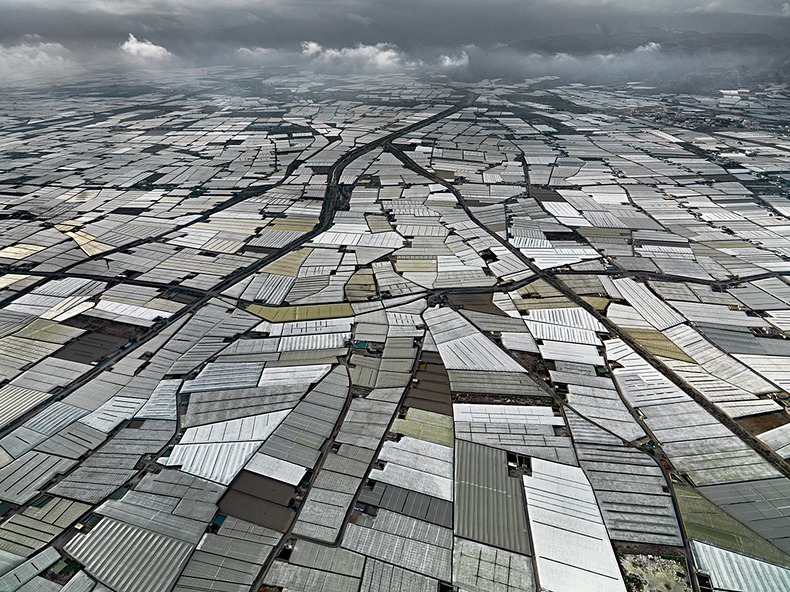Welcome to Debate Club! Please be aware that this is a space for respectful debate, and that your ideas will be challenged here. Please remember to critique the argument, not the author.
Will "unnatural" factory farming produce better food?

bpetrosky
Posts: 3,911 Member
Indoor farms, once a concept from science fiction, are becoming a reality. With new advances in LED lighting and renewable engergy sources, vegetable crops can be grown in a warehouse like building. Crops would be protected from weather, insects and animal, and most diseases. The site could use less water, less pesticides, and could produce crops the whole year. Such sites could be built within urban centers reducing the need to transport vegetables long distances. Less hardy or heirloom type vegetables could be easier and cheaper to produce as well.
My question is would you consider food grown this way somehow inferior to field grown produce? Would the artficial growing environment make it appear less nutritious to you? Would you think of it as tainted by the factory style production environment? What would make it worse than produce grown in the fields?
Personally, I think the crops would be as good as or superior to conventionally grown crops in most cases. The produce would be more fresh, produced with less pesticides and fertilizers, and be a better value than what we currently consider organically grown. More tasty varietals of different crops could be produced as well. Generally, I think it's very promising.

8
Replies
-
I think they'll be the same. You can grow a tomato plant in a windowsill and it tastes the same as the ones grown in the garden.6
-
Simply put.
YES. Controlled environment will likely result in higher, not lower quality products. For example, ensuring appropriate nutrient and hydration for plants is just as important as for people or animals.
Edited to align with how the question was actually written, rather than how I read it the first time.
Ah, I see, the question is asked both ways. BAH!!5 -
I would consider it superior, and good for the environment. I'm all in favor of it.8
-
It would produce higher quality more readily available fruits and veggies. Few pesticides & fungicides would be needed for sure. Lesser chance of contamination from listeria or e-coli. You can't grow everything this way, but you could many things like greens, root veggies, and berries. I don't see how conventionally grown would be any better. I would love to have a hydroponic setup someday and have things like lettuce & spinach available year round.2
-
I think nutritionally they will be very similar taste wise I think they'll taste slightly blander.
Most of the salad I can buy here in Sweden is grown in Hydroponic greenhouse factories. The tomatoes and cucumbers are mostly from high intensty polytunnles.
Last week I was on Cyprus and bought salad from a local farm shop. The taste of the misshapen, slightly odd looking veggies in my Greek salad was much better then what I can get from a supermarket at home.
However, it's probably a mute point as we'll likely need to move to these methods of production to meet demand. So it wouldn't put me off eating them.
Also as you say the lower levels of pesticides and artificial fertilisers released into the environment would likely be a good thing.0 -
I'm not opposed to it in principle. I'd need to know more about actual (as opposed to theoretical) execution.
Greenhouses bring their own challenges. For example:- Some plants will be leggy/spindly without wind, so artificial wind needs to be added. (Not dissing fans, just saying this is a consideration.)
- There are some pests that thrive indoors for certain plants, so measures need to be taken for that.
Why would you need less fertilizer? Because it has less wild to dilute into?2 -
kshama2001 wrote: »I'm not opposed to it in principle. I'd need to know more about actual (as opposed to theoretical) execution.
Greenhouses bring their own challenges. For example:- Some plants will be leggy/spindly without wind, so artificial wind needs to be added. (Not dissing fans, just saying this is a consideration.)
- There are some pests that thrive indoors for certain plants, so measures need to be taken for that.
Why would you need less fertilizer? Because it has less wild to dilute into?
Good points. I could see installing fans on the racks to improve air flow across the plants. Indoor pests would have to be controlled, but a well designed facility and good protocols can address most of that without heavy pesticide use.
As far as fertilizer is concerned, fertilizers used in field grown crops have losses from runoff, overspray, non-growing parts of the field, etc. The indoor farm could mix the nutrients into the irrigation lines feeding the plants, using less fertilizer overall.7 -
I see plenty of advantages to it and little downside. A more consistent/controllable growing environment, decreased need for pesticides, less crop loss/spoilage due to inclement weather conditions, less wastage due to animal/insect scavenging, etc.
I think the quality would be as good, if not better, than conventionally grown crops. The "factory style production environment" doesn't concern me in the least - I'm not one of the people who sees any such thing as inherently evil.5 -
I can see this being a godsend for dense population centers such as Hong Kong or Taiwan as well.4
-
I'm all for it, lab grown meat as well while we're at it. Let's embrace scientific advances!1
-
I think it is sort of going the wrong direction in terms of our energy future. You can think of a typical outdoor farm sort of like a solar plant that harvests energy from the sun for our use. This does the opposite...it drains our power resources and provides less energy and than was input. I think when you contemplate that some of those LEDs would be literally powered by energy from solar farms that inefficiency becomes more apparent.
In a future where all power needs are solved sure....but today, not sure I see the point. In countries that can build LED farm warehouses food isn't that much of an issue...but power is.6 -
Aaron_K123 wrote: »I think it is sort of going the wrong direction in terms of our energy future. You can think of a typical outdoor farm sort of like a solar plant that harvests energy from the sun for our use. This does the opposite...it drains our power resources and provides less energy and than was input. I think when you contemplate that some of those LEDs would be literally powered by energy from solar farms that inefficiency becomes more apparent.
In a future where all power needs are solved sure....but today, not sure I see the point. In countries that can build LED farm warehouses food isn't that much of an issue...but power is.
That's a fair concern, especially since the conversion efficiency of photovoltaic panels is below 25% if I recall correctly. When you factor in the full chain of solar to electric transimission, possibly battery storage, and conversion to light, the total efficiency would be pretty low.
I think the power use of such a facility could be mitigated by several other factors, however. Onsite cogeneration from roof mounted solar and wind and maybe using waste products from the plants. Also we may find we don't need full spectrum inensity lighting for many plants. Selective spectrum lighting at lower intensities may be more than enough for healthy plants.
Timing the light cycles during off-peak generation time is another strategy that comes to mind. We already do something similar to this with pumped storage generation stations that pump water into a reservoir overnight and reverse it during the day during peak time. It makes no sense from an energy efficiency standpoint, but works out economically.
3 -
Aaron_K123 wrote: »In a future where all power needs are solved sure....but today, not sure I see the point. In countries that can build LED farm warehouses food isn't that much of an issue...but power is.
Couple of advantages to weigh against that.
These would take up less land in regions where land is expensive and hard to come by. Water usage would be less (less evaporation) in dryer climates and the ability to grow year round in colder climates.
An interesting idea.
4 -
I have a lot of thoughts about this, I suppose, but many of them aren't quite answering the original question, so I'll do that first.
1. Do I think that food grown indoors is inferior to food grown outdoors? Not necessarily. Grown by aquaponics? That, I think the taste is poorer. There are some folks around here who grow tomatoes with aquaponics during the winter, but just normally in the summer, and there is a noticeable taste difference. The aquaponics tomatoes are simply blander.
I also think that there would be a big learning curve for many plants. There's simply a lot we don't know about a lot of plants at this stage. Like, which plants bolt due to heat, vs. which bolt due to the length of time the sun is up - we know that for some plants, but it hasn't been research in some others. Or another example, we are just now learning just how important the fungus under the ground is for healthier crops, and how often we screw it up when we dig up fields every year to plant (rather like we're learning about how important gut bacteria are in people, and how often we have screwed it up when antibiotics were handed out a bit too often in the past).
I'm not saying that this is an insurmountable problem, just that it's definitely something to be researched, and there is definitely the possibility of inferior crops due to screws in this area, in the early years.
I also think the likelihood is going to be for more chemical usage, not less...it just doesn't seem likely that someone is going to be going with older, and slower, techniques to building rich soil or growing mediums, when they are also going with much more modern ways of growing food indoors.
When it comes to the concept of growing food indoors in general (not just the quality of food), I have to say one thing that comes to mind is that I wish a lot of us thought in aesthetics as well as practicalities, because both are possible
Because while I absolutely agree that having food sources more near the people they are going to sounds great...why make it ugly? Because there are ways to make growing plants/food amazing and beautiful, like they are trying to do in Singapore (although theirs is with plants more than crops, but crops could be similar).
https://www.cnn.com/2012/06/08/world/asia/singapore-supertrees-gardens-bay/index.html
These metal 'trees' in the picture are harvesting both light AND water for growing plants, and have plants growing in them, and up them, as well. And it's lovely and awesome, rather than a big square block of 'blech' that is an eyesore in the middle of a city.
Imagine using something like this to grow crops?
1 -
with no sunlight really no sunlight?2
-
This content has been removed.
-
see the thing that people don't realize that farming - and all the pieces on the farm= cattle crops chickens etc - if worked correctly all work together to get the very best products - but farms don't use the correct system - ive seen it done on a documentary and was like ooooooooooooooo is that what is supposed to happen? its very very interesting.4
-
with no sunlight really no sunlight?
Sure, no natural sunlight required. Cool running LED light banks that generate light in the wavelengths used most by the plants, including infrared, and warming elements if needed for temperature cycling. Would a plant grown with "artificial" photons be deficient?
Actually a thought occurred to me that Detroit has some fantastic underground salt mines that are no longer in production. Naturally climate controlled and quite clean, and a huge space. Imagine a farm 1000 feet underground producing fresh produce year round for all of SE Michigan and NW Ohio.13 -
with no sunlight really no sunlight?
Sure, no natural sunlight required. Cool running LED light banks that generate light in the wavelengths used most by the plants, including infrared, and warming elements if needed for temperature cycling. Would a plant grown with "artificial" photons be deficient.
Actually a thought occurred to me that Detroit has some fantastic underground salt mines that are no longer in production. Naturally climate controlled and quite clean, and a huge space. Imagine a farm 1000 feet underground producing fresh produce year round for all of SE Michigan and NW Ohio.
I'm thinking the same - underground production in limestone caves all throughout the midwestern US. Also unlimited potential in hostile environments - desert/polar regions, space, planetary excursions...which was the driver of this tech.
Agree with Aaron that power is a great concern, but agriculture is by far more impactful to environment than any other development. This is a great option to have available. May not be viable now, but as tech progresses this could be a game changer.6 -
So the common observation most people have had is regarding the flavor of 'greenhouse' tomatoes. I can see that complaint. Does that also happen with other vegetables like peppers or broccoli?
With tomatoes, I think the 'hothouse' varieties are a varietal selected for being easy to slice and transports well. With more local production where we don't have to transport a tomato hundreds of miles, I think we could grow more flavorful varietals instead.4 -
So the common observation most people have had is regarding the flavor of 'greenhouse' tomatoes. I can see that complaint. Does that also happen with other vegetables like peppers or broccoli?
With tomatoes, I think the 'hothouse' varieties are a varietal selected for being easy to slice and transports well. With more local production where we don't have to transport a tomato hundreds of miles, I think we could grow more flavorful varietals instead.
I think you are right on the tomatoes. It's not the growing method that is the issue, but the varietal that is grown is less tasty, but either grows better or transports better.7 -
So the common observation most people have had is regarding the flavor of 'greenhouse' tomatoes. I can see that complaint. Does that also happen with other vegetables like peppers or broccoli?
Broccoli, I do not know. I don't know of any broccoli that is grown in a greenhouse, I expect because it's a cold weather crop, so it's not usually an issue, you know?
For peppers, no personal experience, but I would wonder if any plants in the nightshade family might have similar issues to tomatoes, possibly?
something that occurred to me later was to wonder how pollination would be handled. I see it done by hand in the smaller greenhouses, but I have not idea how large scale production would work.0 -
I guess I'm already doing something similar on a miniature scale with my Aerogardens. Unfortunately, I only just set up my unit with the heirloom tomatoes, so I don't know how they'll compare to the hothouse varieties from the store.0
-
Indoor farms, once a concept from science fiction, are becoming a reality. With new advances in LED lighting and renewable engergy sources, vegetable crops can be grown in a warehouse like building. Crops would be protected from weather, insects and animal, and most diseases. The site could use less water, less pesticides, and could produce crops the whole year. Such sites could be built within urban centers reducing the need to transport vegetables long distances. Less hardy or heirloom type vegetables could be easier and cheaper to produce as well.
They already are. They're called "greenhouses".
Commercial vegetable growers use huge ones all the time.
Some even sell their produce as "organic" and the gullible lap them up.
Farmer's market produce grown in backyards is much more likely to be weak and pest-ridden and is unable to feed many people.
0 -
Indoor farms, once a concept from science fiction, are becoming a reality. With new advances in LED lighting and renewable engergy sources, vegetable crops can be grown in a warehouse like building. Crops would be protected from weather, insects and animal, and most diseases. The site could use less water, less pesticides, and could produce crops the whole year. Such sites could be built within urban centers reducing the need to transport vegetables long distances. Less hardy or heirloom type vegetables could be easier and cheaper to produce as well.
They already are. They're called "greenhouses".
Commercial vegetable growers use huge ones all the time.
Some even sell their produce as "organic" and the gullible lap them up.
Farmer's market produce grown in backyards is much more likely to be weak and pest-ridden and is unable to feed many people.
Indeed. But turn that greenhouse into a windowless facility that looks like a clean room with industrial systems and automation, and I wonder if some people will perceive the products as somehow tainted by the production process or equipment.
Or worse,3 -
Indoor farms, once a concept from science fiction, are becoming a reality. With new advances in LED lighting and renewable engergy sources, vegetable crops can be grown in a warehouse like building. Crops would be protected from weather, insects and animal, and most diseases. The site could use less water, less pesticides, and could produce crops the whole year. Such sites could be built within urban centers reducing the need to transport vegetables long distances. Less hardy or heirloom type vegetables could be easier and cheaper to produce as well.
They already are. They're called "greenhouses".
Commercial vegetable growers use huge ones all the time.
Some even sell their produce as "organic" and the gullible lap them up.
Farmer's market produce grown in backyards is much more likely to be weak and pest-ridden and is unable to feed many people.
Indeed. But turn that greenhouse into a windowless facility that looks like a clean room with industrial systems and automation, and I wonder if some people will perceive the products as somehow tainted by the production process or equipment.
Or worse,
Shh, don't tell them they're already like that. 1
1 -
I guess I'm already doing something similar on a miniature scale with my Aerogardens. Unfortunately, I only just set up my unit with the heirloom tomatoes, so I don't know how they'll compare to the hothouse varieties from the store.
Please let us know when you harvest (hopefully successfully). I would be very interested to know how they taste in comparison.
I was going to bring up tomatoes (and cucumbers) as an example of how things could be blander tasting, but the variety argument is convincing. I usually find myself eating more produce in season because it tastes more flavorful to me. Thankfully tomatoes are always in season here (we have an area suitable for growing tomatoes year round, always warm).
I'm 100% for technological improvements in all areas related to food, even artificial substitutes that are a far departure from the conventional. My only concern is usually flavor because developing technologies are more concerned with making the process viable and the logistics of it than they are with the quality of flavor.0 -
I think they would be better, with less resources.
Excellent Freakanomics podcast on this topic that details the why. Not your normal greenhouse concept.
Exactly the spectrum of light and amount that is needed for optimum growth for different plants. That can be tested.
Just the right amount of water and nutrients. Extra not needed to fight off excess heat or drought.
No pesticides needed.
Easier harvesting.
All things that cut down on massive amounts of energy used for field grown crops.
To balance out the energy needs of doing it inside.
Also the land use is less because seasons don't matter, so no wait time or rotating crops and still having wait time.
1 -
I think they would be better, with less resources.
Excellent Freakanomics podcast on this topic that details the why. Not your normal greenhouse concept.
Exactly the spectrum of light and amount that is needed for optimum growth for different plants. That can be tested.
Just the right amount of water and nutrients. Extra not needed to fight off excess heat or drought.
No pesticides needed.
Easier harvesting.
All things that cut down on massive amounts of energy used for field grown crops.
To balance out the energy needs of doing it inside.
Also the land use is less because seasons don't matter, so no wait time or rotating crops and still having wait time.
Not to mention enhanced availability because there's no such thing as crops being "in season". Seasonal varieties can be available fresh year-round.3 -
I don't mean backyard little greenhouses. I mean large-scale automated hydroponic &/or intensive indoor farming is already here.

eg:
http://www.amusingplanet.com/2013/08/the-greenhouses-of-almeria.html
"Since the 1980s, the small coastal plain, some 30 kilometers southwest of the city of Almeria, has developed the largest concentration of greenhouses in the world, covering 26,000 hectares. Several tons of greenhouse vegetables and fruits such as tomatoes, peppers, cucumbers and zucchinis are produced here annually. More than half of the Europe’s demand for fresh fruits and vegetables are grown under the plastic shades, fuelling the province of Almeria's economy by $1.5 billion in annual revenue.
But 35 years ago, this region in the southeast of Spain was dry and arid, and desert-like, receiving an average of 200 mm of rainfall a year. In fact, Spaghetti western films were once shot here, because the land was so dry and barren.
But with imported soil and fully hydroponic systems that drip-feed chemical fertilizers into grow-bags, over the last 35 years, the area has been intensively used for agriculture."
1
This discussion has been closed.
Categories
- All Categories
- 1.4M Health, Wellness and Goals
- 398.2K Introduce Yourself
- 44.7K Getting Started
- 261K Health and Weight Loss
- 176.4K Food and Nutrition
- 47.7K Recipes
- 233K Fitness and Exercise
- 463 Sleep, Mindfulness and Overall Wellness
- 6.5K Goal: Maintaining Weight
- 8.7K Goal: Gaining Weight and Body Building
- 153.5K Motivation and Support
- 8.4K Challenges
- 1.4K Debate Club
- 96.5K Chit-Chat
- 2.6K Fun and Games
- 4.8K MyFitnessPal Information
- 13 News and Announcements
- 21 MyFitnessPal Academy
- 1.6K Feature Suggestions and Ideas
- 3.2K MyFitnessPal Tech Support Questions
















